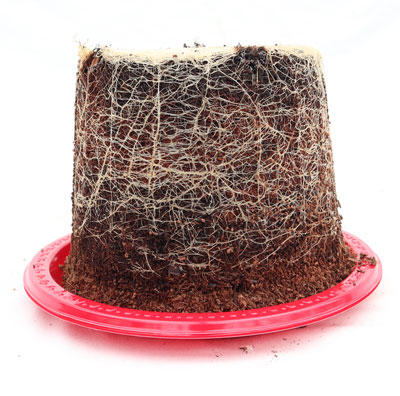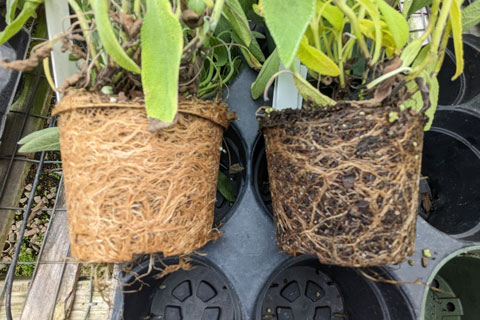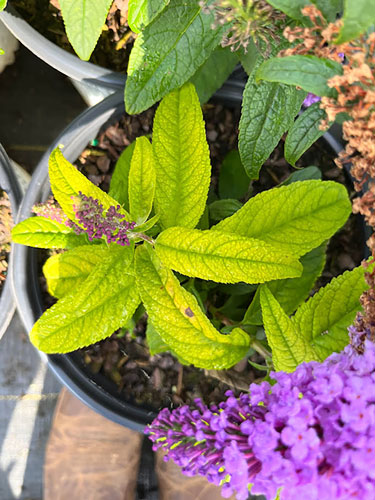1/1/2025
Relearning How to Grow: Substrates
Patrick Veazie & Brian Whipker

Previously published in the e-Gro Alert newsletter.
In recent years, substrate availability has been impacted as a result due to weather and economic concerns, so substrate companies are incorporating new components into traditional soilless growing media. Some of these alternative substrate components include coconut coir and wood fiber. While this alleviates the substrate shortages, these media components have very different physical and chemical properties compared to peat. These new components may take the place of peat in the growing media, and they may not be direct replacements, but instead are alternatives that may take some trialing to learn to master growing with them.
Figure 1: While the substrate at the top may appear dry, the lower portions of the substrate profile are still saturated.
Photo by Patrick Veazie.
These changes in substrate physical properties can result in poor crop growth if you don’t adapt your growing practices to the new attributes of the substrate. One of the most common problems observed for growers who are changing to coir or wood fiber-amended substrates is overwatering. Wood and coir additions can change the water capacities of the substrates. Wood fiber is more hydrophilic compared to peat, so it’ll also dry faster than peat at the surface.
In many cases growers will water when the surface drying of the substrate is observed, however, the rest of the substrate is still saturated (Figure 1). You should check the watering needs of the pot based on the moisture of the entire profile instead of only the visual appearance of the surface. Picking up the pot to determine if it’s heavy is a great method to check the water status of the plant. When the substrate is continually overwatered, negative impacts on plant growth may be observed in a variety of ways, including plant growth stalling, iron deficiency and changes in substrate pH.
Root rot and plant stall
The most common symptom associated with prolonged overwatering is root rot. Root rot is the result of either a fungal or bacterial infection that will turn the roots a dark brown color and the upper portions of the plant will collapse (Figure 2). While root rot may result in plant death, plant stalling is a less noticeable problem that can often occur. The plant stall is often a result of poor root growth due to the high water content in the root zone not allowing for gas exchange within the root. The roots will often turn brown in the impacted areas at the bottom of the pot; however, in dryer regions of the pot (near the soil surface) the roots will remain white.
Once plant stall occurs it’s important to allow the substrates to dry down before additional watering cycles. Monitoring the greenhouse conditions and the weather is important to determine watering needs. The use of bottom heat in colder climates can aid in increasing the root zone temperature to promote root growth, and in turn, nutrient uptake.
Iron deficiency
In some species, overwatering can result in iron (Fe) deficiency. This problem can be very common when automatic irrigation cycles aren’t monitored based on the weather, leading to plants becoming overwatered. Iron chlorosis will be first observed in the upper foliage of the plant as interveinal chlorosis and can progress to entire leaf chlorosis and bleaching (Figure 3). There are a wide variety of causes that can result in Fe deficiency, including high pH, overwatering and calcium (Ca) antagonism.
You should monitor substrate pH and utilize chelated Fe to prevent deficiencies from occurring; however, monitoring the substrate’s moisture levels to promote nutrient uptake is critical. Additionally, when substrate pH increases above the optimal range for iron-inefficient crops, a decrease in micronutrient uptake can occur. Maintaining a substrate pH below 6.2 for most crops can prevent nutrient lockout from occurring.
Changes in substrate pH
Moving to alternative substrates brings inherent changes to substrate chemical properties. Wood and coconut coir have a higher pH compared to peat; replacing a lower pH material with a higher pH material coupled with a lower buffering capacity will shift the substrate pH up compared to traditional peat-perlite substrates.
 Substrate pH can be significantly impacted by your water quality and choice of fertilizer. Fertilizers can generally be broken down into three categories: acidic, neutral or basic. This can be determined by the form of nitrogen that’s listed on the bag. Fertilizers that are generally higher in ammoniacal nitrogen (NH4+; +urea nitrogen, such as 20-10-20) will be more acidic compared to fertilizers composed of higher nitrate (NO3-) concentrates (such as 13-2-13) that will generally be basic. Fertilizers that contain high concentrations of ammoniacal nitrogen can also result in ammonium toxicity if the substrate is continually wet and the growing environment is cold.
Substrate pH can be significantly impacted by your water quality and choice of fertilizer. Fertilizers can generally be broken down into three categories: acidic, neutral or basic. This can be determined by the form of nitrogen that’s listed on the bag. Fertilizers that are generally higher in ammoniacal nitrogen (NH4+; +urea nitrogen, such as 20-10-20) will be more acidic compared to fertilizers composed of higher nitrate (NO3-) concentrates (such as 13-2-13) that will generally be basic. Fertilizers that contain high concentrations of ammoniacal nitrogen can also result in ammonium toxicity if the substrate is continually wet and the growing environment is cold.
Figure 2: Root rot will often be observed as brown roots (right) and shoot wilt; however, the substrate will still be saturated due to lack of uptake. Nice, healthy roots are visible on the plant on the left. Photo by Brian Whipker.
While some fertilizers are more acidic than others, when fertilizer solution is applied to a substrate and nutrient uptake is not occurring the pH will still decrease even when utilizing a basic fertilizer. As a result, it’s important to routinely monitor the substrate pH and EC of a crop to promote adequate plant growth. If substrate pH drops below the recommended range and the EC is high, then clear-water leaching can be an effective method to increase the substrate pH and lower the EC.
 Figure 3: Iron deficiency will be first observed in the new growth as interveinal chlorosis that can progress to entire leaf chlorosis, or in severe cases, bleaching. Photo by Patrick Veazie.
Figure 3: Iron deficiency will be first observed in the new growth as interveinal chlorosis that can progress to entire leaf chlorosis, or in severe cases, bleaching. Photo by Patrick Veazie.
Some species are more sensitive to changes in substrate pH compared to others. Low pH-sensitive species such as marigold and zinnia may result in micronutrient toxicity if the substrate pH drops to below the optimal range. Additionally, high pH can result in micronutrients being less available for plant uptake and can result in deficiencies in some species such as petunia. Matching your fertilizer choice to your substrate characteristics can help maintain an optimal pH and promote plant growth.
Conclusion
The changing substrate supply results in the need for growers to implement alternative substrates. Growers should be aware of their substrate composition and the resulting changes to their growing practices that should be implemented. There are a variety of problems that growers can face; however, with careful monitoring of the substrate pH and modifying watering to match the plants’ needs, many challenges can be avoided. GT
Patrick Veazie is a Ph.D. student at North Carolina State University focusing on floriculture production and soilless substrates. Brian Whipker is a Professor at North Carolina State University focusing on technical floriculture and greenhouse extension.